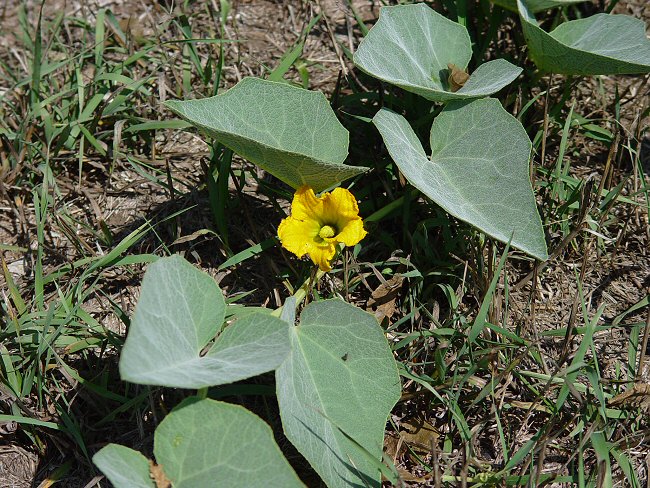Cucurbita foetidissima Kunth
Buffalo Gourd

Introduced
CC = *
CW = 5
MOC = 16
© DETenaglia
Cucurbita foetidissima KunthBuffalo Gourd | |
 |
Introduced CC = * CW = 5 MOC = 16 |
© DETenaglia |
|
Family - Cucurbitaceae Habit - Monoecious, perennial vine with deep, stout, branched, somewhat tuberous roots Stems - Trailing, to 5 m or more long, stout, coarsely roughened and hairy, sometimes rooting at the nodes, usually producing a strong aroma similar to that of garlic, especially when crushed or bruised.
Leaves - Mostly long-petiolate, the petioles 3-12 cm long, lacking glands at the tip, coarsely roughened with stout, multicellular, pustular-based hairs. Blades 10-40 cm long, 6-30 cm wide, triangular to ovate-triangular in outline, distinctly longer than wide, not lobed or with a pair of very shallow lobes toward the base, these broadly triangular, mostly sharply pointed at the tip, the surfaces densely roughened with short, stiff, pustular-based hairs (usually scattered, longer, stouter hairs also present), appearing gray or strongly grayish-tinged.
Inflorescence - Flowers solitary at stem nodes. Flowers - Staminate flowers with longer stalks than those of the pistillate flowers. Calyx lobes 9-20 mm long. Corollas 5-10 cm wide, deeply bell-shaped, 5-lobed, yellow to yellowish orange. Staminate flowers with the filaments fused into a tube except sometimes at the very base (the anthers fused into a headlike mass). Pistillate flowers with 3 staminodes, the hypanthium and calyx moderately to densely hairy, the ovary with numerous ovules per placenta, the stigma 3-5-lobed or more or less 6-10-lobed.
Fruits - Modified berries 6-10 cm long, globose, with a pulpy, fibrous central portion and a relatively thin, hardened shell, indehiscent, with a stalk 15-40 mm long, the surface smooth and glabrous, usually green with irregular lighter longitudinal stripes, bleaching to yellow, tan, or ivory-colored with age. Seeds numerous, 6-10 mm long, elliptic to obovate in outline, flattened, sometimes with a pronounced, thickened rim, mostly rounded at the tip, the surface otherwise smooth, white, cream-colored, or tan, less commonly brown or black.
Flowering - June - September. Habitat - Railroad embankments, roadsides, fields, waste ground. Origin - Native to U.S. and Mexico. Lookalikes - Broadly, other cucurbits. Other info. - This vining pumpkin species can be found in scattered counties throughout Missouri but is generally uncommon in the state. In fact, recent collections are rare, with the last being in 1977. The nativity status in Missouri is somewhat controversial, as it was not collected here until 1891 despite being a large and conspicuous plant, and many of the collections have been along railroads. The plant's main range begins just to the west of Missouri, and it is common throughout the Southwest. The vines and their distinctively shaped leaves, usually with a somewhat grayish cast, are a common sight along roadsides in the west. The distinctive fruits are another good clue to identification, and these will often persist on the ground into the following year. Photographs taken at Tall Grass Prairie National Preserve, KS., 9-20-09 (DETenaglia); also along the San Pedro Riparian National Conservation Area, Cochise County, AZ, 9-7-2013, and near Alamogordo, Otero County, NM, 2-27-2018 (SRTurner). |